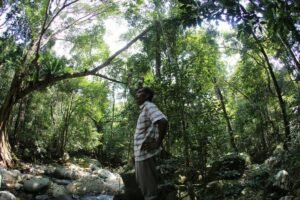
October 28, 2019; Columbia Journalism Review
Last month, on October 1, the Associated Press (AP) ran a story titled, “Indigenous filmmaker strikes playful tone with showcase ad.” The story would be unexceptional, except for one thing—it was the first time AP had ever distributed a story in mainstream US media that had originated from a Native American publication.
It seems stunning that AP, founded in 1846, had not sourced a single article from a Native publication for 173 years. But that certainly appears to be the case. “In the whole history of media this hasn’t happened before,” Aliyah Chavez, a Kewa Pueblo tribal member and the author of the story the AP picked up, tells Valerie Vande Panne of Columbia Journalism Review. “It’s super exciting.” Panne adds, “If the old adage—that good journalism is the first draft of history—is true, then October 1, 2019, marked the first time in mainstream US media that history was written by a Native publication about Indian Country.”
Even better, the publication involved is Indian Country Today, which shut its doors two years ago and whose rebirth was at first highly uncertain. Fortunately, a transfer in ownership from the Oneida nation to the National Congress of American Indians was realized, and Indian Country Today was relaunched in March 2018 as a nonprofit.
Associated Press is structured as a member-owned cooperative. Now Indian Country Today is one of its newest members.
According to Panne, both parties seem pleased with the new partnership:
Jim Clarke, the AP’s Director for the West, notes that the collaboration with Indian Country Today “helps the wires and our collective journalism”…
Sign up for our free newsletters
Subscribe to NPQ's newsletters to have our top stories delivered directly to your inbox.
By signing up, you agree to our privacy policy and terms of use, and to receive messages from NPQ and our partners.
Indian Country Today’s membership in the AP enables the AP to run Indian Country Today’s reporting on their wire, and enables Indian Country Today to run AP stories on their website…
In addition, when Indian Country Today picks up a tribal newspaper’s story, they can not only run it on their own website, but also make it available to the AP and, through them, to the nation’s newspapers.
Its achievement of AP membership speaks to the rapid recovery of Indian Country Today under the leadership of Mark Trahant, a Shoshone-Bannock member and a highly accomplished journalist. Panne notes that since the relaunch, readership has grown to “500,000 unique users monthly, up from 160,000 a year ago.”
Trahant, adds Panne “has followed a public-television model for financial support—grants, foundation dollars, and a periodic membership drive—and is basing the publication’s newsrooms on university campuses, with a main bureau at Arizona State University’s Cronkite School in Phoenix and one about to open at Alaska Pacific University in Anchorage.”
Panne notes, “The Anchorage office puts Indian Country Today on the frontlines of climate change in the Arctic, and in the heart of the state with the highest percentage of recognized Natives in the US. The outlet also has a bureau in Washington, DC.” The publication, which initially relaunched with two employees in the spring of 2018, expects to have 24 Native reporters once the Anchorage office opens, a number that Trahant says matches or exceeds “the total number of Native American reporters at all mainstream media outlets.”
Tristan Ahtone, a Kiowa member and President of the Native American Journalists Association, says the Indian Country Today collaboration with AP makes him hopeful that there will be greater mainstream media coverage of Native Americans in the future: “It seems to me a good step by the AP to reach out to indigenous reporters.”
He adds: “It’s vitally important that there is good and accurate reporting on Indian Country and that audiences outside Indian Country see that reporting. Accurate coverage by indigenous people about and for indigenous people is a big step—especially for the AP, who, like many legacy and mainstream media outlets, need a lot of help getting the story right.”—Steve Dubb











